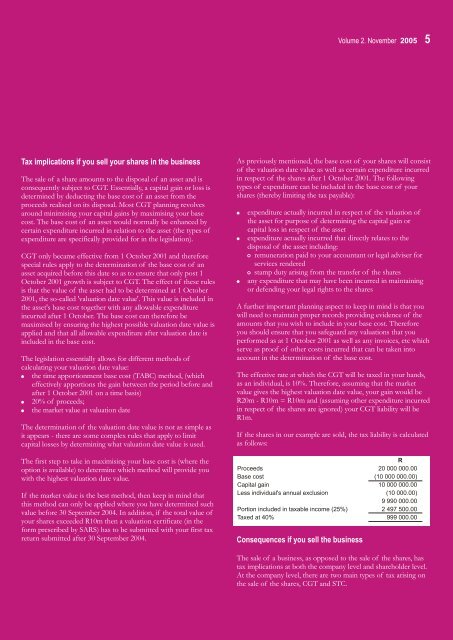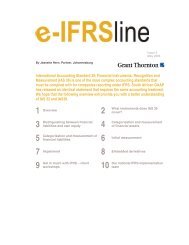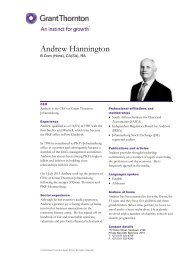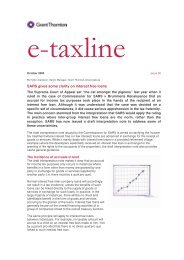IFRS - there's nowhere to hide - Grant Thornton
IFRS - there's nowhere to hide - Grant Thornton
IFRS - there's nowhere to hide - Grant Thornton
You also want an ePaper? Increase the reach of your titles
YUMPU automatically turns print PDFs into web optimized ePapers that Google loves.
Volume 2. November 2005 5<br />
Tax implications if you sell your shares in the business<br />
The sale of a share amounts <strong>to</strong> the disposal of an asset and is<br />
consequently subject <strong>to</strong> CGT. Essentially, a capital gain or loss is<br />
determined by deducting the base cost of an asset from the<br />
proceeds realised on its disposal. Most CGT planning revolves<br />
around minimising your capital gains by maximising your base<br />
cost. The base cost of an asset would normally be enhanced by<br />
certain expenditure incurred in relation <strong>to</strong> the asset (the types of<br />
expenditure are specifically provided for in the legislation).<br />
CGT only became effective from 1 Oc<strong>to</strong>ber 2001 and therefore<br />
special rules apply <strong>to</strong> the determination of the base cost of an<br />
asset acquired before this date so as <strong>to</strong> ensure that only post 1<br />
Oc<strong>to</strong>ber 2001 growth is subject <strong>to</strong> CGT. The effect of these rules<br />
is that the value of the asset had <strong>to</strong> be determined at 1 Oc<strong>to</strong>ber<br />
2001, the so-called 'valuation date value'. This value is included in<br />
the asset's base cost <strong>to</strong>gether with any allowable expenditure<br />
incurred after 1 Oc<strong>to</strong>ber. The base cost can therefore be<br />
maximised by ensuring the highest possible valuation date value is<br />
applied and that all allowable expenditure after valuation date is<br />
included in the base cost.<br />
The legislation essentially allows for different methods of<br />
calculating your valuation date value:<br />
the time apportionment base cost (TABC) method, (which<br />
effectively apportions the gain between the period before and<br />
after 1 Oc<strong>to</strong>ber 2001 on a time basis)<br />
20% of proceeds;<br />
the market value at valuation date<br />
The determination of the valuation date value is not as simple as<br />
it appears - there are some complex rules that apply <strong>to</strong> limit<br />
capital losses by determining what valuation date value is used.<br />
The first step <strong>to</strong> take in maximising your base cost is (where the<br />
option is available) <strong>to</strong> determine which method will provide you<br />
with the highest valuation date value.<br />
If the market value is the best method, then keep in mind that<br />
this method can only be applied where you have determined such<br />
value before 30 September 2004. In addition, if the <strong>to</strong>tal value of<br />
your shares exceeded R10m then a valuation certificate (in the<br />
form prescribed by SARS) has <strong>to</strong> be submitted with your first tax<br />
return submitted after 30 September 2004.<br />
As previously mentioned, the base cost of your shares will consist<br />
of the valuation date value as well as certain expenditure incurred<br />
in respect of the shares after 1 Oc<strong>to</strong>ber 2001. The following<br />
types of expenditure can be included in the base cost of your<br />
shares (thereby limiting the tax payable):<br />
<br />
<br />
<br />
expenditure actually incurred in respect of the valuation of<br />
the asset for purpose of determining the capital gain or<br />
capital loss in respect of the asset<br />
expenditure actually incurred that directly relates <strong>to</strong> the<br />
disposal of the asset including:<br />
remuneration paid <strong>to</strong> your accountant or legal adviser for<br />
services rendered<br />
stamp duty arising from the transfer of the shares<br />
any expenditure that may have been incurred in maintaining<br />
or defending your legal rights <strong>to</strong> the shares<br />
A further important planning aspect <strong>to</strong> keep in mind is that you<br />
will need <strong>to</strong> maintain proper records providing evidence of the<br />
amounts that you wish <strong>to</strong> include in your base cost. Therefore<br />
you should ensure that you safeguard any valuations that you<br />
performed as at 1 Oc<strong>to</strong>ber 2001 as well as any invoices, etc which<br />
serve as proof of other costs incurred that can be taken in<strong>to</strong><br />
account in the determination of the base cost.<br />
The effective rate at which the CGT will be taxed in your hands,<br />
as an individual, is 10%. Therefore, assuming that the market<br />
value gives the highest valuation date value, your gain would be<br />
R20m - R10m = R10m and (assuming other expenditure incurred<br />
in respect of the shares are ignored) your CGT liability will be<br />
R1m.<br />
If the shares in our example are sold, the tax liability is calculated<br />
as follows:<br />
R<br />
Proceeds 20 000 000.00<br />
Base cost (10 000 000.00)<br />
Capital gain 10 000 000.00<br />
Less individual's annual exclusion (10 000.00)<br />
9 990 000.00<br />
Portion included in taxable income (25%) 2 497 500.00<br />
Taxed at 40% 999 000.00<br />
Consequences if you sell the business<br />
The sale of a business, as opposed <strong>to</strong> the sale of the shares, has<br />
tax implications at both the company level and shareholder level.<br />
At the company level, there are two main types of tax arising on<br />
the sale of the shares, CGT and STC.


